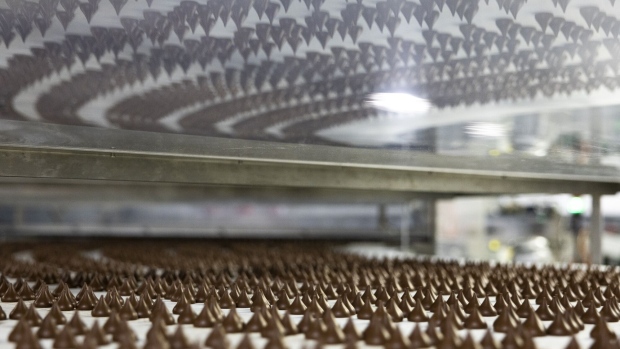Mar 23, 2023
At Hershey, Salty Snacks Are What Executives Crave
, Bloomberg News

(Bloomberg) -- At the Hershey Co. headquarters on Chocolate Avenue, even though you can’t escape the smell of sweet fudge, the talk of the town is all about salty snacks.
Most known for its bite-size chocolate Kisses and Reese’s brand treats, Hershey executives spent their first investor day since 2017 touting the promising results from two of its most recent acquisitions: SkinnyPop and Dot’s Homestyle Pretzels.
SkinnyPop, acquired in 2017 for $1.6 billion, netted $495 million in retail sales in 2022 and Dot’s, acquired in 2021, generated $335 million that year, according to a Wednesday presentation. Hershey also acquired Pirate’s Booty, a puffed cheese snack, in 2018 and candy maker Lily’s Sweets and Pretzel’s Inc. in 2021.
The brand declined to provide revenue figures for its portfolio of confectionery brands like Jolly Rancher and Twizzlers.
The results have motivated company executives to look for other M&A targets to keep attracting consumers.
Hershey expects salty snacks, which are 10% of the company’s portfolio, to make up roughly 20% of sales over the next 10 years, with executives hoping to grow the division to $3 billion from $1 billion in revenue, according to Kristen Riggs, who heads that division of the business. Executives declined to disclose more specifics on their M&A strategy.
“We’re looking for things that could bring us new consumers, new consumer occasions that have a tie into what we already do,” Hershey’s Chief Financial Officer Steve Voskuil said in a Wednesday interview with Bloomberg.
The confections seller is determined to make further acquisitions in an effort to hold on to its pandemic-era growth amid robust demand from an inflation-battered consumer base.
Missed opportunities
Its West Hershey production facility in Pennsylvania is a far cry from Willy Wonka’s chocolate waterfalls and edible meadows. Instead, rows of pumps, automated scales and refrigerated conveyor belts help produce roughly 24 million standard Hershey bars and 70 million Kisses a day. Still, for executives, its output over the last five years hasn’t been enough.
“We’ve had degraded service levels. We’ve missed out on a lot of opportunities to meet demand,” said Will Bonifant, who helps lead the company’s US and Canada supply chain.
The maker of Kit Kat Bars seems to have weathered the storm of supply-chain snarls, tallying 10 quarters of year-over-year revenue growth since the third quarter of 2020. Hershey will aim to keep its brand relevant by tying its treats to family functions, holidays and sporting events such as March Madness.
Its most recent earnings report beat Wall Street estimates and executives provided a 2023 outlook that forecast net sales growth between 6% and 8%.
But the company sees itself wrangling to stay affordable enough for people to keep making those impulse purchases. Hershey’s profitability still hasn’t recovered amid higher costs, despite price increases, Voskuil said.
Hershey also hopes to stay out of the spotlight of the culture wars as right-wing activists call for a boycott of the brand over its inclusion of a transgender rights activist in its Canadian International Women’s Day campaign. A Hershey’s spokesperson said that campaign stands separate from any US-focused advertisements.
The Daily Wire, a conservative publication, released its own brand of chocolate bars in an attempt to mock the commercial.
Read More: Hershey Stands By Ads Featuring Trans Activist Despite Backlash
“We want to celebrate women, and we’ve done this campaign for a number of years, and we allow a level of regional customization,” Voskuil said. “In general, we’re not looking to be in the fray — that’s really not what we’re about.”
©2023 Bloomberg L.P.


